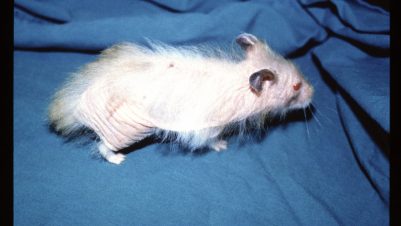Lichenification is a term describing a common cutaneous reaction to chronic disease. The skin becomes markedly thickened with exaggerated markings so that the end result in severe cases may resemble elephant skin (Miller and others, 2013).
Hyperpigmentation frequently accompanies lichenification, especially in its most chronic form. The majority of cases are the result of an underlying pruritic skin disease with selftrauma from rubbing and scratching responsible for the lesion. Rubbing by friction as in intertrigo is also a possible cause. There are a number of underlying causes. These include (from Hnilica and Paterson, 2017):
- Atopy.
- Food hypersensitivity/intolerance.
- Pyoderma – secondary to an underlying cause.
- Malassezia dermatitis, primary or secondary.
- Demodicosis.
- Scabies.
- Chronic endocrine disorders with secondary microbial infection.
- Keratinisation disorders.
- Primary (idiopathic) acanthosis nigricans of the dachshund. This is a rare, possibly inherited disease affecting young dachshunds in the axillary region.
Diagnosis
- Whatever the underlying cause, many dogs with lichenified skin have secondary pyoderma caused most commonly by Staphylococcus pseudintermedius and/or Malassezia dermatitis due to Malassezia pachydermatis. An assessment of this complication can be made by cytological examination of the skin surface and also by response to specific therapy.
- Once secondary complications have been effectively treated, an investigation of the possible underlying cause is made.
- With parasitic causes, skin scrapings and tape strips performed to search for antimicrobial infection may have discovered causative mites.
- Tape strips and skin scrapings are advisable at subsequent examinations, however, even if they were negative initially.
- Allergic skin disease should be considered if other differentials have been eliminated by initial treatment and diagnostic tests. Atopy and/or food allergy are important underlying causes for lichenified skin.
Management
- It is necessary to treat the secondary complications described above before assessment of underlying causes.
- Topical therapy with antimicrobial shampoos containing 2% chlorhexidine and 2% miconazole is initially favoured, particularly in less severe cases. More severe cases may require, in addition to the topical therapy described, systemic anti-yeast and anti-bacterial drugs given long-term as suggested below.
- Those dogs with a predominantly Malassezia infection (Figure 5) may respond rapidly within a few weeks. There will often be a marked reduction in the level of pruritus following treatment. If underlying allergic conditions are present the pruritus will remain, albeit at a lower level.
- Pyoderma cases will need longer treatment – from three weeks to several months depending on the severity of the infection. Pruritus at a lower level will be present if there is a pruritic underlying cause, but will be absent if the pyoderma is associated with an underlying non-pruritic disease such as hypothyroidism.
- Topical treatment for antimicrobial secondary complications should be continued three times weekly while investigations of possible underlying causes continue.
- Atopy is a common cause of chronic pruritus leading to lichenified skin. It is suggested from the history, breed, age of onset, site of pruritus and rule-outs of differentials.
- There are several effective treatments that control atopicdermatitis that are not discussed in this article, but it is important to ensure that secondary complications have been successfully treated to ensure maximum control. Figures 1, 2, 3 and 4 show an atopic dog with secondary pyoderma before and after treatment.
- Depending on the severity of lichenification and hyperpigmentation, it may take many months to achieve good control and in those cases with underlying causes such as atopy, control will need to be on-going for life.
References
Hnilica, K. A. and Paterson, A. P. (2017) Small Animal Dermatology: A Color Atlas and Therapeutic Guide; 578-581. Elsevier. Miller, W. H., Griffin, C. E. and Campbell, K. L. (2013) Muller and Kirk’s Small Animal Dermatology; 78.








-1628179421-401x226.jpg)


